August 14, 2013
In this week’s column, members of IRA’s Children’s Literature and Reading Special Interest Group consider the question, “What makes a great read?” A great book should have fresh creative writing, powerful illustrations (if in picturebook or illustrated formats), and deal with universal themes about life and humanity. It should surprise you in some way: make you gasp, make you laugh, make you question and wonder, make you cry, or bring you to new insights. The books reviewed in this article are “great reads” that help young readers learn about themselves, others, and the world around them. The authors of these books address issues of diversity related to identity development, difference, and sexuality. These books also help readers explore and understand the world: how it was formed, how we are connected to and impact the Earth, and what happens beyond our world and solar system. We hope teachers, parents, and children read, re-read, and ponder these “great reads” to find what resonates.
GRADES K-2
Empson, Jo. (2012). Rabbityness. Auburn, ME: Child’s Play Inc.
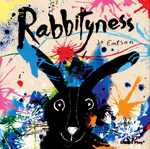 Rabbityness is a debut book by author/illustrator Jo Empson. In vibrant water-media paintings, readers see Rabbit explore his artistic and musical interests–very un-rabbity things to do. Rabbit’s friends enjoy the color and life he brings to the forest until, one day, he disappears. His friends are left wondering what happened to him, and are overcome with feelings of sadness and loss. Rabbit’s friends find a way to remember him and bring joy back to the forest and their hearts. Empson deals with the topics of difference and loss in both sensitive and poignant ways that are appropriate for young children. Her bright, colorful illustrations, reminiscent of Stephen Gammell’s artwork, balance the heaviness of the topic of losing a loved one.
Rabbityness is a debut book by author/illustrator Jo Empson. In vibrant water-media paintings, readers see Rabbit explore his artistic and musical interests–very un-rabbity things to do. Rabbit’s friends enjoy the color and life he brings to the forest until, one day, he disappears. His friends are left wondering what happened to him, and are overcome with feelings of sadness and loss. Rabbit’s friends find a way to remember him and bring joy back to the forest and their hearts. Empson deals with the topics of difference and loss in both sensitive and poignant ways that are appropriate for young children. Her bright, colorful illustrations, reminiscent of Stephen Gammell’s artwork, balance the heaviness of the topic of losing a loved one.
- Jennifer Sanders, Oklahoma State University
Rosenthal, Amy Krouse, & Lichtenheld, Tom. (2013). Exclamation mark. New York, NY: Scholastic Press.
 Exclamation mark “wasn’t like everyone else. He was confused, flummoxed, and deflated” by his difference until he met a friend who helped him discover his abilities and possibilities. With one sentence per page and sparse black-line illustrations, this appears to be a simple book about punctuation marks and their usage; however, it deals with complex and ageless themes of feeling different from others and finding one’s place in the world. Children of all ages can explore the layers of meaning in this picturebook: trying to fit in, being discouraged and confused, thinking about running away, being imprisoned by not being one’s self, and learning to be confident in who you are.
Exclamation mark “wasn’t like everyone else. He was confused, flummoxed, and deflated” by his difference until he met a friend who helped him discover his abilities and possibilities. With one sentence per page and sparse black-line illustrations, this appears to be a simple book about punctuation marks and their usage; however, it deals with complex and ageless themes of feeling different from others and finding one’s place in the world. Children of all ages can explore the layers of meaning in this picturebook: trying to fit in, being discouraged and confused, thinking about running away, being imprisoned by not being one’s self, and learning to be confident in who you are.
- Jennifer Sanders, Oklahoma State University
GRADES 3-5
Cavanaugh, Nancy J. (2013). This journal belongs to ratchet. Illus. by Jillian Rahn. Naperville, IL: Jabberwocky.
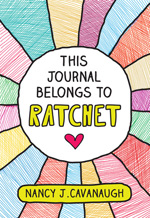 Summer is here. Eleven-year-old Ratchet, aka Rachel, has big plans to improve her life. In her homeschool language arts journal, awash in variety of writing styles, poems, and drawings, she outlines steps to become, stylish, make a friend, and discover more about her mother, who died when Ratchet was five. Told in the lively and longing voice of a lonely girl being raised by an eccentric, environmentalist father and who is wishing for a social life and a mother, Ratchet reveals her dreams to “turn my old, freakish, friendless, motherless, life into something shiny and new.” How she accomplishes this, while saving a park, winning an essay contest, connecting with her father, and making friends with a boy whom she helps to build a go-cart, is an engaging and uplifting read.
Summer is here. Eleven-year-old Ratchet, aka Rachel, has big plans to improve her life. In her homeschool language arts journal, awash in variety of writing styles, poems, and drawings, she outlines steps to become, stylish, make a friend, and discover more about her mother, who died when Ratchet was five. Told in the lively and longing voice of a lonely girl being raised by an eccentric, environmentalist father and who is wishing for a social life and a mother, Ratchet reveals her dreams to “turn my old, freakish, friendless, motherless, life into something shiny and new.” How she accomplishes this, while saving a park, winning an essay contest, connecting with her father, and making friends with a boy whom she helps to build a go-cart, is an engaging and uplifting read.
- Beverly Vaughn Hock, Co-director of Nye Memorial Children's Literature Study Tours
Cooke, Lucy. (2013). A little book of sloth. New York, NY: Margaret K. McElderry Books.
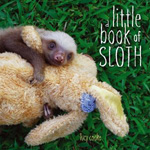 Despite the occasional use of anthropomorphism, this is a delightful, informational book about a little known animal–the sloth. Cooke helps readers to see sloths in a new way–as affectionate, smiling, cuddly creatures that need care and sanctuary when they are orphaned, injured, or fall into the hands of cruel people. Cooke shares surprising information about how sloths can’t make their own body heat, how they use stuffed animals as surrogate hugging partners, and how some form strong friendships with other sloths. Readers will fall in love with the sloths of the Aviarios del Caribe sloth sanctuary as they read this book. While the purpose of this book is to educate readers about sloths, it can also serve as a lens into a different way of life. Throughout the book, the author tells readers to take a tip from the sloth’s “slo-mo lifestyle” and “just chill.” With older readers, parents and teachers could facilitate discussions and inquiries about different cultural ways of being and different ways of perceiving time and the pace of life.
Despite the occasional use of anthropomorphism, this is a delightful, informational book about a little known animal–the sloth. Cooke helps readers to see sloths in a new way–as affectionate, smiling, cuddly creatures that need care and sanctuary when they are orphaned, injured, or fall into the hands of cruel people. Cooke shares surprising information about how sloths can’t make their own body heat, how they use stuffed animals as surrogate hugging partners, and how some form strong friendships with other sloths. Readers will fall in love with the sloths of the Aviarios del Caribe sloth sanctuary as they read this book. While the purpose of this book is to educate readers about sloths, it can also serve as a lens into a different way of life. Throughout the book, the author tells readers to take a tip from the sloth’s “slo-mo lifestyle” and “just chill.” With older readers, parents and teachers could facilitate discussions and inquiries about different cultural ways of being and different ways of perceiving time and the pace of life.
- Jennifer Sanders, Oklahoma State University
Kelsey, Elin. (2012). You are stardust. Illus by Soyeon Kim. Toronto, Canada: Owl Kids Books.
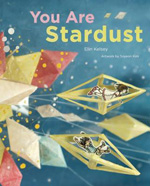 In You are Stardust, Elin Kelsey describes how people and the Earth (even the universe) are intimately connected, from the beginning of time and into the present. We began as stardust–elements formed during the lifecycle of stars that eventually became the elements that make up our beings. Saltwater serves as the fluid of life on Earth, in the wombs of mothers, and in our bodies. And each breath we breathe out spreads microscopic pollens through the air to flower the plants of the world. The interconnectedness of all life and nature is conveyed in a magical, wonder-ful way through both the writing and So-yeon Kim’s three-dimensional, diorama images. Kim uses thin threads to visually represent the connectedness of people and nature in her whimsical, cut paper images. Visit www.owlkidsbooks.com/stardust to read more about the scientific explanations for the statements in the book and to view teacher resources for facilitating students’ inquiries.
In You are Stardust, Elin Kelsey describes how people and the Earth (even the universe) are intimately connected, from the beginning of time and into the present. We began as stardust–elements formed during the lifecycle of stars that eventually became the elements that make up our beings. Saltwater serves as the fluid of life on Earth, in the wombs of mothers, and in our bodies. And each breath we breathe out spreads microscopic pollens through the air to flower the plants of the world. The interconnectedness of all life and nature is conveyed in a magical, wonder-ful way through both the writing and So-yeon Kim’s three-dimensional, diorama images. Kim uses thin threads to visually represent the connectedness of people and nature in her whimsical, cut paper images. Visit www.owlkidsbooks.com/stardust to read more about the scientific explanations for the statements in the book and to view teacher resources for facilitating students’ inquiries.
- Jennifer Sanders, Oklahoma State University
Zullo, Germano. (2013). Line 135. Illus. by Albertine. San Francisco, CA: Chronicle Books.
 Belonging is a feeling that every child needs and seeks. Some children don’t ever find a place they connect with or a family to belong to, but perhaps Line 135 will help readers envision the unlimited possibilities of places to belong. The unnamed girl in Line 135 belongs to two places: her house in the city and her grandmother’s house in the country. She travels between the two places on a green rail train through pen-and-ink landscapes embellished by her imagination. She yearns to be a child of the world, however, and not just of her mother’s city and her grandmother’s countryside. Her mother and grandmother tell her it is “impossible” to know the entire world, as the girl desires. The girl refuses to be deterred from her dreams by the pessimism of her well-meaning mother and grandmother. In powerful language that evokes a poetic feeling, this translated book conveys a child’s curiosity about the world and her yearning to explore its wonders.
Belonging is a feeling that every child needs and seeks. Some children don’t ever find a place they connect with or a family to belong to, but perhaps Line 135 will help readers envision the unlimited possibilities of places to belong. The unnamed girl in Line 135 belongs to two places: her house in the city and her grandmother’s house in the country. She travels between the two places on a green rail train through pen-and-ink landscapes embellished by her imagination. She yearns to be a child of the world, however, and not just of her mother’s city and her grandmother’s countryside. Her mother and grandmother tell her it is “impossible” to know the entire world, as the girl desires. The girl refuses to be deterred from her dreams by the pessimism of her well-meaning mother and grandmother. In powerful language that evokes a poetic feeling, this translated book conveys a child’s curiosity about the world and her yearning to explore its wonders.
- Jennifer Sanders, Oklahoma State University
GRADES 6-8
DeCristofano, Carolyn Cinami. (2012). A black hole is not a hole. Illus by Michael Carroll. Watertown, MA: Charlesbridge Publishing, Inc.
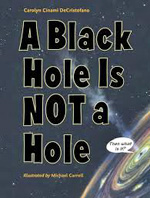 Carolyn DeCristofano hits a home run with this fascinating book about black holes. She takes a sophisticated scientific topic and breaks it down into clear, manageable concepts that middle grades readers will be able to grasp, beginning with easier concepts and gradually moving to the more complex ideas. Through the skillful use of figurative language and comparisons and contrasts, DeCristofano helps readers understand extreme gravity zones and the distortion of space that happens as dense matter interacts with it. Two extended comparisons–a black hole being like a whirlpool and being similar to a hole in an object–help readers to visualize the abstract scientific principles at work in black holes. Readers are also guided through “thought experiments” to image how light is absorbed and bent by black holes as well as what it might be like to travel into a black hole. Descriptions of recent scientific explorations of black holes and “supermassive” black holes will leave readers with additional inquiries that can be investigated with the support of the backmatter and references listed at the end of the book. A Black Hole is Not a Hole is a powerful informational book that helps children understand the world, our solar system and galaxy, and the galaxies beyond.
Carolyn DeCristofano hits a home run with this fascinating book about black holes. She takes a sophisticated scientific topic and breaks it down into clear, manageable concepts that middle grades readers will be able to grasp, beginning with easier concepts and gradually moving to the more complex ideas. Through the skillful use of figurative language and comparisons and contrasts, DeCristofano helps readers understand extreme gravity zones and the distortion of space that happens as dense matter interacts with it. Two extended comparisons–a black hole being like a whirlpool and being similar to a hole in an object–help readers to visualize the abstract scientific principles at work in black holes. Readers are also guided through “thought experiments” to image how light is absorbed and bent by black holes as well as what it might be like to travel into a black hole. Descriptions of recent scientific explorations of black holes and “supermassive” black holes will leave readers with additional inquiries that can be investigated with the support of the backmatter and references listed at the end of the book. A Black Hole is Not a Hole is a powerful informational book that helps children understand the world, our solar system and galaxy, and the galaxies beyond.
- Jennifer Sanders, Oklahoma State University
GRADES 9-12
Gansworth, Eric. (2013). If I ever get out of here. New York, NY: Arthur A. Levine.
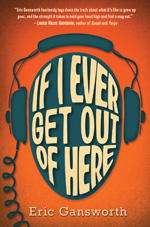 Lewis is the only kid from the reservation in the “brainiac” track at school. At best, the other kids don’t talk to him; at worst, a bully whose name affords him immunity from punishment brutalizes him. When a new kid in town crosses the barrier and befriends him, Lewis finds himself in new territory, literally, as he is invited to visit George’s family on a local military base. Embarrassed by his extreme poverty, Lewis lies to keep his friends away from his own home. Strains from Beatles and Wings soundtracks, with “guest appearances” by Queen’s Freddy Mercury, provide the back beat for this 70s period piece that is at once funny and poignant. With nuanced, respectful characterization and richly detailed narrative, If I Ever Get Out of Here addresses the hard questions of poverty and prejudice—its roots and realities—while also celebrating family, community, and the gifts of culture.
Lewis is the only kid from the reservation in the “brainiac” track at school. At best, the other kids don’t talk to him; at worst, a bully whose name affords him immunity from punishment brutalizes him. When a new kid in town crosses the barrier and befriends him, Lewis finds himself in new territory, literally, as he is invited to visit George’s family on a local military base. Embarrassed by his extreme poverty, Lewis lies to keep his friends away from his own home. Strains from Beatles and Wings soundtracks, with “guest appearances” by Queen’s Freddy Mercury, provide the back beat for this 70s period piece that is at once funny and poignant. With nuanced, respectful characterization and richly detailed narrative, If I Ever Get Out of Here addresses the hard questions of poverty and prejudice—its roots and realities—while also celebrating family, community, and the gifts of culture.
- Sue Christian Parsons, Oklahoma State University
Konigsberg, Bill. (2013). Openly straight. New York, NY: Arthur A. Leviine Books.
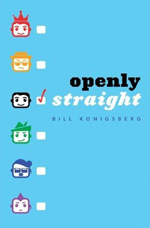 Rafe is openly gay, has loving, supportive parents, and his mother is president of Parents and Friends of Lesbians and Gays (PFLAG). They live in progressive Boulder, Colorado where his gayness is generally a non-issue. The problem is that Rafe feels like he is defined by “the gay kid” label and wonders what it would be like to be just Rafe, not gay Rafe. Attending an all-boy boarding school across the country in Boston seems like the perfect opportunity for Rafe to figure out who he is without the label. Rafe is able to develop new friendships that he wasn’t able to when he was known as “gay Rafe.” His scheme of being openly straight (or just not mentioning that he’s gay) seems to be working. But as Rafe’s friendships deepen and a bromance turns to romance, he slams into the realization that a relationship can’t be built upon deceit. Rafe’s story doesn’t end all neatly packaged and tied with a bow, which makes it feel all the more real. Koningsberg skillfully and sensitively weaves issues of love, identity development, homophobia, coming out, and trust in a compelling and witty plot that revolves around complex, captivating characters.
Rafe is openly gay, has loving, supportive parents, and his mother is president of Parents and Friends of Lesbians and Gays (PFLAG). They live in progressive Boulder, Colorado where his gayness is generally a non-issue. The problem is that Rafe feels like he is defined by “the gay kid” label and wonders what it would be like to be just Rafe, not gay Rafe. Attending an all-boy boarding school across the country in Boston seems like the perfect opportunity for Rafe to figure out who he is without the label. Rafe is able to develop new friendships that he wasn’t able to when he was known as “gay Rafe.” His scheme of being openly straight (or just not mentioning that he’s gay) seems to be working. But as Rafe’s friendships deepen and a bromance turns to romance, he slams into the realization that a relationship can’t be built upon deceit. Rafe’s story doesn’t end all neatly packaged and tied with a bow, which makes it feel all the more real. Koningsberg skillfully and sensitively weaves issues of love, identity development, homophobia, coming out, and trust in a compelling and witty plot that revolves around complex, captivating characters.
- Jennifer Sanders, Oklahoma State University
These reviews are submitted by members of the International Reading Association's Children's Literature and Reading Special Interest Group (CL/R SIG) and are published weekly on Reading Today Online. The International Reading Association partners with the National Council of Teachers of English and Verizon Thinkfinity to produce ReadWriteThink.org, a website devoted to providing literacy instruction and interactive resources for grades K–12.